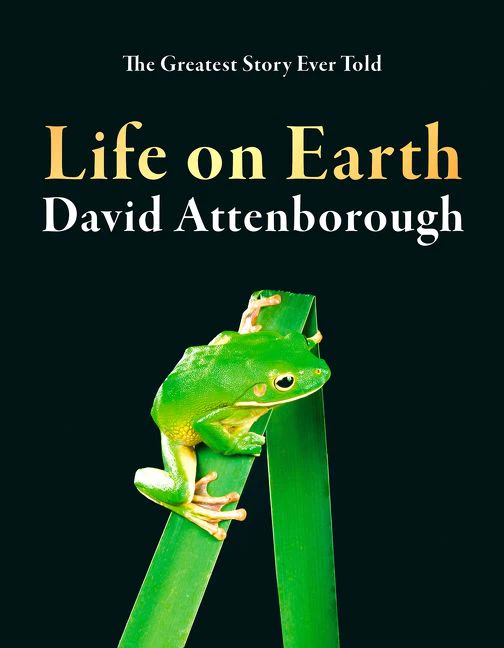Soh Kam Yung reviewed Life on Earth by David Attenborough
An updated version of Sir David Attenborough's book that accompanies the TV series
4 stars
An updated version of the book originally released with the documentary series, "Life on Earth", the book gives a splendid overview of the various multicellular lifeforms we know about. Each chapter covers a specific living kingdom (animal or plant) but has been updated with the latest scientific information about them.
"The Infinite Variety" gives an overview of the huge variety of life on Earth. After a brief introduction to Evolution by Natural Selection, the reader is then shown the geologic time scale of the Earth compressed into a year, and where along it the various forms of life (from single celled organisms to humans) arose. A look at the possible earliest forms of life is then shown, followed by the evolution of single-celled organisms and the rise of the earliest multi-celled organisms like the sponges, jellyfish and corals. Palaeontology, geology and DNA studies are used to show how much we …
An updated version of the book originally released with the documentary series, "Life on Earth", the book gives a splendid overview of the various multicellular lifeforms we know about. Each chapter covers a specific living kingdom (animal or plant) but has been updated with the latest scientific information about them.
"The Infinite Variety" gives an overview of the huge variety of life on Earth. After a brief introduction to Evolution by Natural Selection, the reader is then shown the geologic time scale of the Earth compressed into a year, and where along it the various forms of life (from single celled organisms to humans) arose. A look at the possible earliest forms of life is then shown, followed by the evolution of single-celled organisms and the rise of the earliest multi-celled organisms like the sponges, jellyfish and corals. Palaeontology, geology and DNA studies are used to show how much we know (and don't know) about such early forms of life.
"Building Bodies" looks at the first animals to appear in the ocean. These can be divided into three groups: the shelled animals, animals with radial symmetry and those with segmented bodies but all came from a common ancestor. One of the descendants of that common ancestor developed a shell and became the molluscs which branched out into snails, bivalves, swimming nautilus, cuttlefish and the octopus. Another is the crinoids, which developed a radially symmetrical body around the centre. Some developed a five fold symmetry, leading to the starfishes and other echinoderms. The third started with a segmented body, leading to the worms and other creatures with an external shell like the famous trilobites, other creatures as revealed in the Burgess shale as well as the crabs, lobsters and shrimps.
"The First Forests" looks at, as the title implies, the first forests that rose on land. They were not spectacular, covering only the shores and consisting of plants like moss and liverworts. Into them can the first herbivores, the millipedes, followed by carnivores like centipedes, scorpions and spiders (and also amphibians). As plants got the ability to grow taller, to compete for light, and developed roots to search for water, they began to move inland. These are the early ferns and horsetails. Insects that could climb and fly, like bristletails and dragonflies, lived in these new forests. Other plants like cycads and conifers also appeared that broke the dependence on water for reproduction. Other flying insects, like beetles, bees, butterflies and flies followed the dragonflies into the air. This lead to the development of flowers, whose plants would make use of these insects to pollinate them. This relationships would become so successful that some plants would come to depend on specific insects for pollination and some insects would come to depend on certain plants to nourish their young.
"The Swarming Hordes" refers to, of course, the insects, probably the most numerous and successful group of animals on the planet. Starting with a description of their external skeletons, the chapter moves on to show how insects develop and grow, either from a larva form that resembles the adult, or from a larva form that greatly differs from the adult and goes through a metamorphosis. The various insects are limited only by size but some insects over come this by forming large, social groups. Termites (relatives of the cockroaches) were one of these groups, building huge mounds to ventilate their huge underground nests. Other insect groups like wasps, bees and ants also formed societies, with some groups of ants forming formidable marching armies.
"The Conquest of the Waters" looks at the creatures that live in the water. Starting with simple organisms like anemones and sea squirts, the jawless fish (like lampreys) then appeared, followed by armoured, bottom feeding fish. Gills and jaws later developed, followed by the various fins that allowed these fish to become more efficient swimmers and predators. Fishes then separated into two groups: those with cartilage, like the rays and sharks, and the bony fish. The bony fish then developed swim bladders and specialised into various forms for different environments, from the open ocean to coral reefs and streams. The senses used by the fish are covered, from their unique lateral lines for sensing pressure, their eyes, ears and sensitive nostrils to the amazing electrical sensors used by electric eels. The chapter then ends with the salmon, who migrates from the ocean to the rivers that they were born in, requiring the use of the adaptations fishes have developed to survive and make their way to where they were born using the Earth's magnetic field and their sense of smell.
"The Invasion of the Land" starts with looking at the mudskipper and what it can tell us about how fish move and breath out of water. Looking at the coelacanth and the lungfish give a better idea of how the ancestors of the first land creatures, the amphibians, looked like. Some would become salamanders. Some salamanders have reverted to mainly water living forms (like the axolotl). Another group of amphibians would burrow into the ground, becoming the caecilians. One other group would become the frogs and toads and develop various ways to minimise their dependence on water, especially for breeding.
"A Watertight Skin" looks at the reptiles who broke their dependence on water by developing a water-tight skin and eggs. Reptiles are ectothermic, whose body temperature depends on the environment and have a long history, starting with the age of the dinosaurs, who would dominate the earth until most of the dinosaurs went extinct possibly due to an asteroid strike. The groups of reptiles that would remain after that event would be the crocodilians, the largest of the reptiles, the tortoises and turtles, who would develop hard shells and the lizards, who would develop scales that would be put to use for defence, display and for movement (the feet of climbing geckos). Snakes would arise from the early lizards, lost their limbs and move in their own way with various methods to catch prey, from constriction to developing venoms.
"Lords of the Air" first takes a look at the feather and how, in its different forms, it helps the keeps descendants of the dinosaurs, the birds, protected and enables them to fly. The various adaptations of the birds, from hollow bones, air sacs, gizzards and beaks, are then described. The different ways birds fly are shown, from the swift fliers, the effortless gliders and those that migrate over vast distances. Feathers can also be used for decoration, either for camouflage or for mating displays. The most well know of such displaying birds are the New Guinea Birds of Paradise. Taking care of eggs and raising chicks is shown to be a dangerous business and birds have to either disguise the eggs or prepare hiding places or elaborate nests to incubate the eggs. Finally, despite being master of flight, birds have a tendency to give up flight whenever possible (like on islands with no predators).
"Eggs, Pouches and Placentas" features the mammals but concentrates on one particular set of mammals, the marsupials. Starting with the platypus and echidna, the possible evolution of the marsupials in South America is discussed, followed by the dispersal of the marsupials into Australia. A number of strategies used by marsupial to give birth to and carry their young in a pouch are shown, ending with the Kangaroos, who have developed a system of delivering young in various stages of development that is suitable for their way of living in the grasslands of Australia. The placental mammals are also briefly discussed, mainly to show the differences between the way the two types of mammals develop their young.
"Theme and Variation" looks at some of the ways mammals have developed and evolved after the ending of the age of dinosaurs. The earliest mammals were probably tiny insectivores like the shrews and moles. From would also rise more specialised insectivores like the pangolin, the armadillo and anteaters. Gliding mammals like the colugo hint at how the bats came to fly. The bats would become very successful and branch out from insects to other sources of food like nectar, fruits and blood (the vampire bat). In the water, the whales and dolphins would develop, become some of the biggest and fastest marine animals.
"The Hunters and the Hunter" first looks at the placental mammals that eat the plants. Forests were the initial environment for the herbivores and they developed various ways to deal with their food. Some stuffed their mouths and the retreat to their lairs to eat at leisure. Others developed various digestive methods to deal with the vegetation. As leaves are not very nutritious, most forest herbivores are solitary and the animals that hunted them were also solitary. With the development of grasses and grass plains, the herbivores moved to occupy the new environment, which has its own challenges, like the lack of places to hide. Some become burrowers like the naked mole rats. Others, like the prairie dogs, developed a sophisticated social system to communicate and keep watch on predators. The unusual herbivores of South America like the giant ground sloth are given a brief look before moving on to the major grass gazers, the horses and antelopes. To hunt them on the open plain, some hunters like the cheetah depend on speed while others like the lions and hyenas depend on teamwork.
"A Life in the Trees" looks at the primates and related groups. it starts with the Borneo tree shrew who may resemble the early primates. A look at the prosimians is then given, made up of the lemurs of Madagascar and the tarsiers of South East Asia. The primate family is then looked at, divided into the New World monkeys with their prehensile tails, the tree living ones from the Old World and finally the ground dwelling primates like the gorillas and chimpanzees that are most like us.
"The Compulsive Communicators" is of course, about human. Starting with the hominins, the rise of the modern human is described, using the latest findings about our ancestors and relatives like the Neanderthals and Denisovans, especially from our DNA. The need for groups to act together to hunt and gather food lead to communication, which lead to greater gatherings and the need for better communication. In the end, human civilisation arose. But it is important to note that we are not the end all of evolution; new species may well arise in the future to replace us in time to come.

